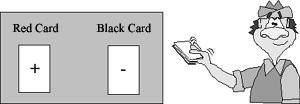Red and black
This task is about calculations with negative numbers.

|
Denis has a pack of cards in which each card is either black or red. Each card has a number on it.
The red cards show positive numbers and the black cards show negative numbers.
For example, a red 4 represents 4, but a black 6 represents ⁻6.
|
|
a) Denis draws out two cards and multiplies the numbers together.
Find the answers he gets for each of these combinations of cards.
|
|||
| 1st card | × 2nd card |
= Answer
|
|
|
i)
ii)
iii)
iv)
|
Red 3
Black 4
Black 8
Red 6
|
× Red 9
× Red 6
× Black 5
× Black 5
|
= __________
= __________
= __________
= __________
|
|
b) Next Denis draws out three cards. He multiplies the first two and then adds the third. Find the answers he gets for each of these combinations of cards. |
|
1st card |
× 2nd card |
+ 3rd card |
= Answer |
|
|
i)
ii)
iii)
iv)
|
Red 5
Black 6
Black 8
Black 3
|
× Red 3
× Red 4
× Red 4
× Black 2
|
+ Black 4
+ Red 10
+ Black 5
+ Black 7
|
= __________
= __________
= __________
= __________
|

